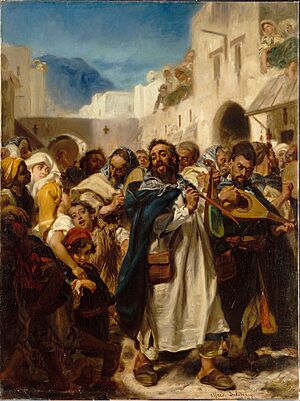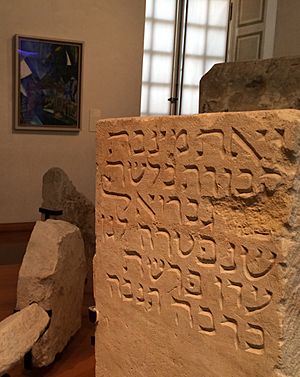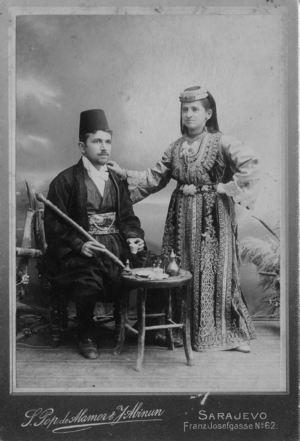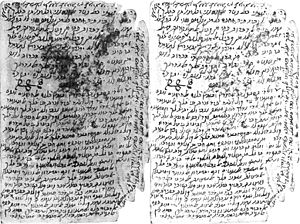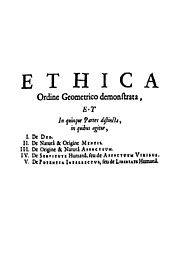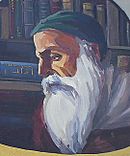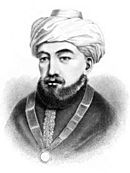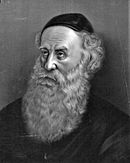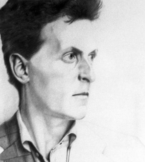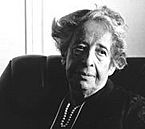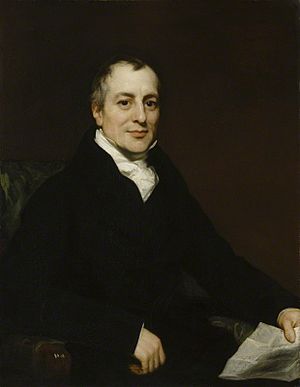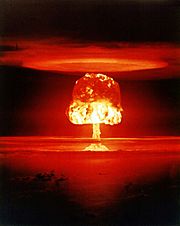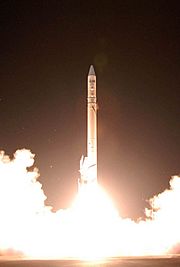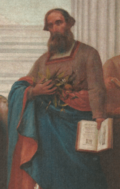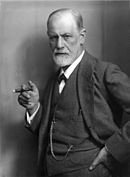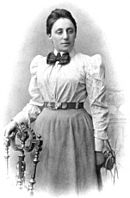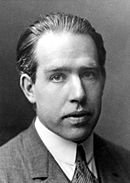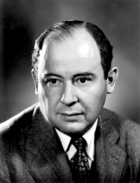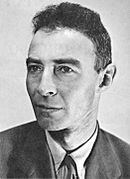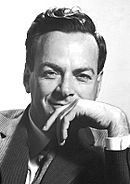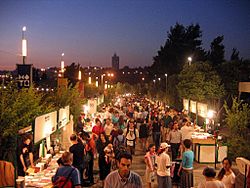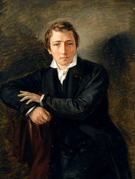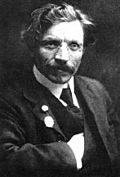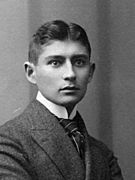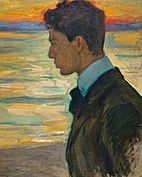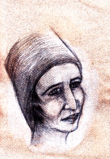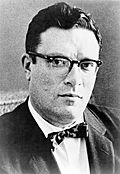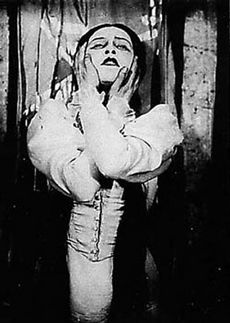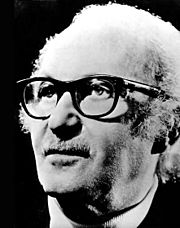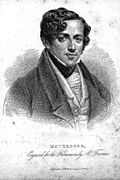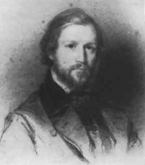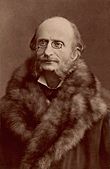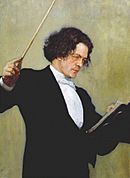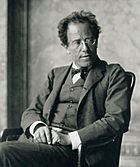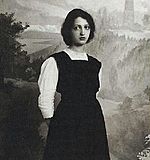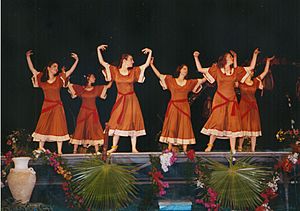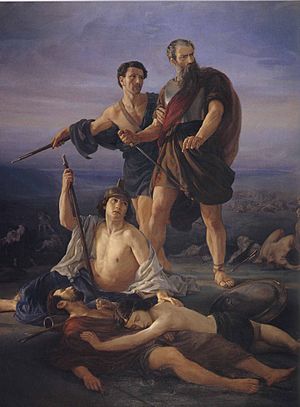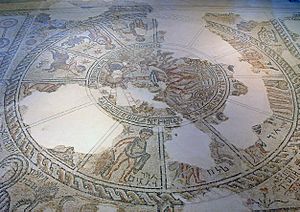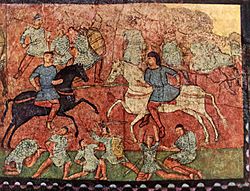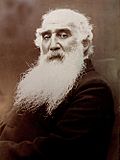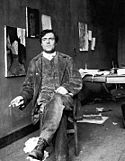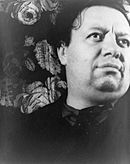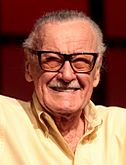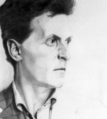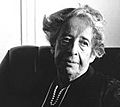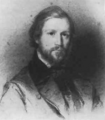Jewish culture facts for kids
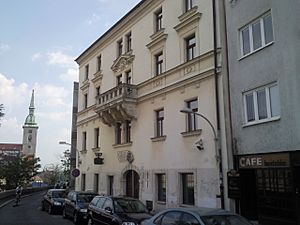
Jewish culture is the way of life, traditions, and beliefs of the Jewish people. It has grown and changed from ancient times until today. Judaism is not just a religion based on faith. It's also about actions, practices, and a shared identity. It's like being part of a family or group with a common background.
Jewish culture includes many things. These are religion, ways of seeing the world, books, movies, art, food, clothes, and music. It also covers how Jewish people view family, marriage, and social customs. Some parts of Jewish culture come from within Judaism itself. Others come from how Jewish people have lived alongside other groups. And some come from how Jewish communities have changed over time. Before the 1700s, religion was a huge part of almost all Jewish life. But later, a non-religious Jewish culture also started to grow.
Contents
- A Look at Jewish History
- Jewish Thought and Beliefs
- Education and Community Life
- Economic Activities and Contributions
- Science and Technology Achievements
- Literature and Poetry
- Theatre Arts
- Cinema and Film
- Radio and Television
- Music and Sounds
- Dance Traditions
- Jewish Humor
- Visual Arts
- Comics, Cartoons, and Animation
- Cuisine and Food
- Philo-Semitism (Appreciation of Jewish Culture)
- See also
- Images for kids
A Look at Jewish History
The Jewish people have not had one single government since the ancient united monarchy. Since then, Jewish groups have lived in many different places around the world. This is known as the Jewish diaspora. By the 1800s, Ashkenazi Jews mostly lived in Eastern and Central Europe. Sephardi Jews were found in many communities around the Mediterranean region. Mizrahi Jews lived mainly across Western Asia. Other Jewish groups lived in Central Asia, Ethiopia, the Caucasus, and India.
Even though they were spread out, these Jewish communities often communicated and traveled between each other. For example, many Sephardic Jews moved to Ashkenazi communities after the Spanish Inquisition. Many Ashkenazi Jews also moved to the Ottoman Empire. However, in some ways, Jewish groups were kept separate from the cultures around them. This happened through ghettos (special areas where Jews were forced to live) and certain laws in Muslim lands. Religious leaders also sometimes discouraged contact with people who worshipped many gods.
During the Middle Ages, Jewish communities in Eastern Europe kept their unique cultural ways. Even with new ideas from the Age of Enlightenment (which also influenced Judaism through the Haskalah movement), many Yiddish-speaking Jews in Eastern Europe still saw themselves as a distinct group. They adapted the idea of being an ethnic group whose identity didn't only depend on religion.
The Haskalah, combined with the Jewish Emancipation movement in Europe, allowed Jews to join wider society. At the same time, attacks called pogroms in Eastern Europe caused many Jews to move, especially to the United States. About 2 million Jewish immigrants settled there between 1880 and 1920. By 1931, before The Holocaust, most of the world's Jewish population was Ashkenazi. This is why much of what people think of as "secular Jewish culture" today comes from Jewish cultural movements in Central and Eastern Europe. These ideas were then brought to North America by immigrants.
During the 1940s, the Holocaust destroyed most Jewish communities in Europe. This, along with the creation of Israel and the movement of Jews from Arab lands, caused more big changes in where Jewish people lived.
It's hard to define non-religious culture for those who follow traditional Judaism. This is because their whole way of life is deeply connected to religious traditions. The idea of separate ethnic and religious identities is not part of the traditional Hebrew view of "the people of Israel." This is especially true for Orthodox Judaism. In North America, secular Jewish groups are part of organizations like the Society for Humanistic Judaism.
Jewish Thought and Beliefs
Jewish philosophy includes all the deep thinking done by Jews or related to Judaism. This thinking spans different periods in Jewish history: ancient, medieval, and modern.
Ancient Jewish philosophy is found in the Bible. It includes ideas like believing in one God and that God is separate from the world. The Bible also talks about the creation of the world. Other biblical writings, like Psalms, encourage admiring God's wisdom. The book of Ecclesiastes is often seen as a true philosophical work in the Hebrew Bible. Its author tries to understand humanity's place in the world and life's meaning.
During the Hellenistic era, Hellenistic Judaism tried to mix Jewish religious traditions with Greek culture and philosophy. The philosopher Philo used stories and symbols to combine Greek and Jewish ideas. His work influenced early Christian thinkers.
Between ancient and medieval times, Jewish philosophy focused on Rabbinic literature like the Talmud and Midrash. In the 800s, Saadia Gaon wrote the first organized book explaining Jewish beliefs. The Golden age of Jewish culture in Spain (from the 900s to 1100s) had many important Jewish thinkers. The most famous was Maimonides, who was also a great philosopher in the Islamic and Western worlds.
In modern times, Jewish philosophy was shaped by thinkers like Baruch Spinoza in the 1600s. His work helped lay the groundwork for the Age of Enlightenment. Moses Mendelssohn in the 1700s was another key figure. He is seen as a leader of the Haskalah (Jewish Enlightenment). Many other important Jewish philosophers lived in the 1800s and 1900s, including Ludwig Wittgenstein and Hannah Arendt.
| Philo (c. 25 BCE–c. 50 CE)) |
Nahmanides (1194–1270) |
Maimonides (1135/1138–1204) |
Baruch Spinoza (1632–1677) |
Moses Mendelssohn (1729–1786) |
|---|---|---|---|---|
| Schneur Zalman of Liadi (1745–1812) |
Ludwig Wittgenstein (1889–1951) |
Hannah Arendt (1906–1975) |
Menachem Mendel Schneerson (1902–1994) |
|
Education and Community Life
Jewish culture has always highly valued education. This value is deeply rooted in Jewish traditions. In recent centuries, non-religious Jews in Europe and the Americas have often supported left-leaning political ideas. They played important roles in the labor movement and socialism in the 1800s. Even conservative Jews have often supported the idea of different religions and beliefs living together peacefully. This might be because Judaism doesn't expect its followers to try and convert others. Also, most Jews have lived as minorities in other countries.
Economic Activities and Contributions
In the Middle Ages, laws in Europe often stopped Jews from owning land. This encouraged them to work in other jobs that non-Jewish Europeans didn't want to do. For example, lending money and charging interest was looked down upon by Christians. But the Church's rules against charging interest didn't apply to Jews. So, Jews became important in the money-lending business.
Kings often supported Jews because they could borrow money from them without facing Church punishment. However, kings often took the wealth that Jews earned through banking. This is one reason why the stereotype of Jews as bankers or merchants began. As modern banking grew, loans became necessary for business. Jews were able to become important in finance by offering these services.
Science and Technology Achievements
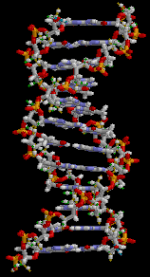
The strong Jewish tradition of religious study often prepared Jews well for academic study. In some places, Jews were not allowed to study at universities or only in small numbers. Despite this, over the centuries, Jews have been very active in academics, professions, finance, business, and many scientific fields. A large number of Nobel Prize winners (22% between 1901 and 2014) have been Jewish or of Jewish background. This shows their strong presence in science and academia.
Early Jewish involvement in science can be seen in the Hebrew Bible. Some books describe the physical world. The Bible also contains rules for cleanliness and protecting natural resources, like trees and birds.
During the Middle Ages, astronomy was a key field for Jewish scholars. Abraham Zacuto published a Hebrew book in 1478 about the Solar System. His work helped Portuguese explorers like Vasco da Gama and Christopher Columbus. A crater on the Moon is named after Zacuto.
Garcia de Orta, a Portuguese Jewish doctor in the 1500s, was a pioneer in Tropical medicine. He wrote about substances and diseases from India, like cholera. The Moon crater Messala is named after the Jewish astronomer Mashallah ibn Athari.
Albert Einstein, a German-born theoretical physicist, is one of the most famous scientists in history. He is often called the "father of modern physics." His work on relativity theory changed physics and astronomy in the 1900s. It replaced Isaac Newton's 200-year-old theory of mechanics. Relativity helped us understand elementary particles and led to the nuclear age. Einstein's work also influenced the Big Bang theory and Quantum mechanics.
Many Jewish scientists played a big role in the Manhattan Project. This project created the first atomic bombs during World War II. The physicist Robert Oppenheimer, often called the "father of the atomic bomb," led the project at Los Alamos. Other key Jewish scientists included Leó Szilárd (who thought of the nuclear chain reaction), Edward Teller (the "father of the hydrogen bomb"), and Richard Feynman.
In quantum mechanics, many important figures were Jewish. These include Niels Bohr (atom structure), Max Born, and Richard Feynman.
Sigmund Freud, known as the father of psychoanalysis, was one of the most influential scientists of the 1900s. He created a way to treat mental health issues by talking with patients. He developed techniques like free association and explored the unconscious.

John von Neumann, a mathematician and physicist, made huge contributions to many fields. These include foundations of mathematics, game theory, and computing. He suggested the Von Neumann architecture for computers. Emmy Noether was a very important mathematician known for her work in abstract algebra and theoretical physics. Her theorem explains the link between symmetry and conservation laws in physics.
Other notable Jewish scientists include Heinrich Hertz (electromagnetism), Carl Sagan (space science), and Edward Witten (M-theory).
Besides scientific discoveries, Jews have also created many important inventions. These include the first car (Siegfried Marcus), the disc record phonograph (Emile Berliner), the laser (Theodore Maiman), and the wireless remote control (Robert Adler). More recently, Jews co-created Google (Sergei Brin and Larry Page) and PHP (Zeev Suraski and Andi Gutmans). Ralph H. Baer is known as "The Father of Video Games."
| Garcia de Orta (1501/2–1568) |
Sigmund Freud (1856–1939) |
Albert Einstein (1879–1955) |
Emmy Noether (1882–1935) |
|---|---|---|---|
| Niels Bohr (1885–1962) |
John von Neumann (1903–1957) |
Robert Oppenheimer (1904–1967) |
Richard Feynman (1918–1988) |
Literature and Poetry
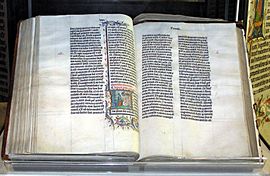
In places with many Jews, unique non-religious Jewish cultures have grown. For example, Jewish writers and artists were a huge part of life in Vienna in the late 1800s. The same was true for New York City 50 years later. Many of these creative Jews were not very religious. Generally, Jewish art and literature have reflected the culture of the places where Jews lived.
Non-religious Jewish literature and theater can be in Jewish languages like Hebrew, Yiddish, or Ladino. Or it can be in the language of the surrounding culture, like English or German. Yiddish literature and theater started in the 1800s but declined by the mid-1900s. The modern use of Hebrew, beyond religious services, began in the early 1900s and is linked to Zionism.
Jewish authors have created their own special Jewish literature. They have also added to the national literature of many countries. Yiddish writers like Sholem Aleichem and Isaac Bashevis Singer (who won a Nobel Prize) wrote about Jewish life in Eastern Europe and America. In the United States, Jewish writers like Philip Roth and Saul Bellow are considered great American authors. They often include a distinct Jewish view in their works. The poetry of Allen Ginsberg often touches on Jewish themes. Other famous Jewish authors include Heinrich Heine, Franz Kafka, and Isaac Asimov.
About 13% of Nobel Prize winners in Literature have been Jewish.
Another type of Jewish writing is ethical literature, called Musar literature. This has been written by both religious and non-religious authors.
Hebrew poetry has been created by many poets throughout Jewish history. Biblical poetry is found in the Hebrew Bible. In medieval times, Jewish poetry was mainly religious songs and poems by poets like Yehuda Halevi. Modern Hebrew poetry began with the revival of the Hebrew language and includes poets like Hayim Nahman Bialik.
| Yehuda Halevi (c. 1075–1141) |
Heinrich Heine (1797–1856) |
Sholem Aleichem (1859–1916) |
Franz Kafka (1883–1924) |
Boris Pasternak (1890–1960) |
Ayn Rand (1905–1982) |
Isaac Asimov (1920–1992) |
Allen Ginsberg (1926–1997) |
|---|---|---|---|---|---|---|---|
Theatre Arts
Yiddish Theatre
The first professional Yiddish-language theatre group was started in Romania in 1876 by Abraham Goldfaden. Soon, Yiddish theater became very popular in Eastern Europe and New York City. Between 1890 and 1940, over a dozen Yiddish theatre groups performed in New York City alone. They put on new plays, musicals, and Yiddish versions of other works. One of the most famous Yiddish plays is The Dybbuk (1919).
In the early 1900s, Yiddish theater in New York was as good as, or even better than, English-language theater. However, the next generation of American Jews spoke mostly English. They brought the energy of Yiddish theater into mainstream American theater, but often with less specific Jewish themes.
European Theatre
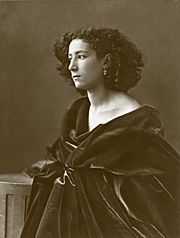
From the time Jews gained more rights (Emancipation) until World War II, they were very active in European theatre. After the Holocaust, many Jews continued to contribute. For example, in Germany before the Nazis, Jews often held acting, directing, and writing jobs. Jews also made important contributions to theatre in Austria, Britain, France, and Russia. In places like Vienna and German cities, Jews found cabaret (a type of entertainment with music, comedy, and drama) to be a popular way to express themselves.
English-language Theatre
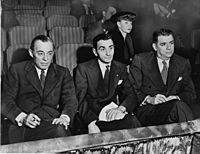
In the early 1900s, New York's lively Yiddish Theatre District influenced Broadway. Jewish immigrants brought new ideas from Europe, like theatrical realism (making plays seem very real). They also helped create and develop the American musical. Many experts say that there would be no American musical without Jews.
In the 1800s and early 1900s, European operetta (a lighter form of opera) often featured Jewish composers like Jacques Offenbach. Jewish comedians and actors like Jack Benny and The Marx Brothers also explored vaudeville (a type of stage entertainment).
By 1910, Jews made up a quarter of New York City's population. Jewish artists quickly began to influence the city's culture. The first "book musicals" (musicals with a strong story) were written by Jewish authors like Jerome Kern and George Gershwin. From then until the 1980s, most successful musical theatre composers and writers were Jewish. They include Rodgers and Hammerstein and Stephen Sondheim. About 70% of nominated scores for the Tony Award for Best Original Score have been by Jewish composers.
Many Jewish writers used musicals to explore themes like fitting into society, accepting outsiders, and overcoming challenges. They often used subtle stories to make their points. For example, Show Boat and South Pacific aimed to promote tolerance and harmony. Later, shows like Fiddler on the Roof directly addressed Jewish subjects.
Many famous Jewish producers, directors, and performers have shaped theatre. These include Joseph Papp and Jerome Robbins. Jewish playwrights like Arthur Miller and Neil Simon have also written important non-musical plays. About 34% of plays and musicals that have won the Pulitzer Prize for Drama were written by Jewish Americans.
Hebrew and Israeli Theatre
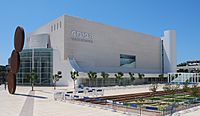
The earliest known Hebrew plays were written around 1550 in Italy. These early plays were about biblical or mystical topics. In the 1800s, many Jews translated famous European plays into Hebrew. They often changed the characters' names to Jewish ones and set the stories in Jewish contexts.
Modern Hebrew theatre began with the development of Modern Hebrew in Europe. It was closely linked to the Jewish national movement of the 1900s. These traditions soon moved to Israel. Playwrights like Hanoch Levin and A. B. Yehoshua have written Hebrew-language plays. Common themes include the Holocaust, the Arab–Israeli conflict, and what it means to be Jewish. Israel's national theatre is the Habima.
Judeo-Tat Theatre
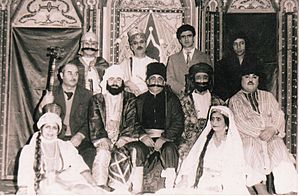
The first theatre event by Mountain Jews happened in 1903. A teacher named Asaf Agarunov staged a story translated from Hebrew. In 1935, the first Soviet Union theatre opened in Derbent, which included a Mountain Jewish group. This group was based on drama clubs led by Manashir and Khanum Shalumov.
During World War II, many actors from the theatre joined the army, and many died. The theatre closed in 1948 but reopened in the 1960s. In the 1970s, the People's Judeo-Tat theatre was formed. It was led for many years by Abram Avdalimov. The theatre faced another crisis in the 1990s but was able to restart its activities in 2000.
Cinema and Film
Over 100 films were made in Yiddish when Yiddish theatre was popular. Many of these films are now lost. Famous Yiddish films include Yidl Mitn Fidl (1936) and Dybuk (1937).
Many Jewish business leaders have been important in the American film industry. These include Samuel Goldwyn, Louis B. Mayer, and Steven Spielberg. However, most of them did not bring a specifically Jewish style to their films.
A more Jewish feeling can be seen in the films of the Marx Brothers, Mel Brooks, or Woody Allen. Other examples of Jewish-themed Hollywood films include Yentl (1983). Today, Jewish film festivals are held in many cities around the world to show these types of films.
Radio and Television
The first major radio networks in America, Radio Corporation of America and Columbia Broadcasting System, were created by Jewish Americans David Sarnoff and William S. Paley. These innovators also helped produce early televisions. Among Jewish immigrant communities in America, there was also a popular Yiddish radio, especially from the 1930s to the 1950s.
While there is little specifically Jewish television in the United States, Jews have been involved in American television from the start. From Sid Caesar and Milton Berle to Jerry Seinfeld, Jewish comedians have been famous on American television. Other important Jewish figures in early radio and television include Eddie Cantor and Jack Benny.
One of the first TV comedies, The Goldbergs, was set in a Jewish neighborhood in the Bronx. Jews have also played a huge role as creators and writers of TV comedies. These include Woody Allen, Mel Brooks, and Larry David.
More recently, American Jews have been important in creating complex TV series like The Wire (created by David Simon) and The Sopranos (produced by Matthew Weiner). Other notable Jewish creators include David Benioff and D. B. Weiss (Game of Thrones), and David Crane and Marta Kauffman (Friends). Many Jewish actors have also become famous on TV, such as Sarah Jessica Parker and Jerry Seinfeld.
Music and Sounds
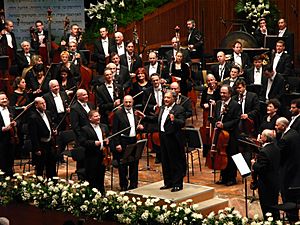
Jewish musical contributions often reflect the cultures of the countries where Jews live. This is seen in classical and popular music in the United States and Europe. However, some music is unique to specific Jewish communities. Examples include Israeli music, Klezmer (Eastern European Jewish folk music), and Sephardic and Ladino music.
Classical Music
Before Jews gained more rights, almost all Jewish music in Europe was religious. There were few Jewish classical musicians until the 1800s. After Jews were allowed into mainstream society, their contributions to European music grew. But this was usually in the form of mainstream European music, not specifically Jewish music. Famous Jewish Romantic composers include Felix Mendelssohn from Germany and Gustav Mahler from Bohemia. Many famous violin and piano players were also Jewish, such as Jascha Heifetz.
In the 1900s, more Jewish composers and musicians emerged worldwide. Examples include Arnold Schoenberg from Austria and George Gershwin from the United States. While most orchestral works by Jewish composers are considered non-religious, many have included Jewish themes in their music. Sometimes this was hidden, like the klezmer sounds some believe are in Mahler's Symphony No. 1. In the 1900s, many Jewish composers wrote music with clear Jewish themes, such as Leonard Bernstein's Kaddish Symphony.
| Giacomo Meyerbeer (1791–1864) |
Fanny Mendelssohn (1805–1847) |
Felix Mendelssohn (1809–1847) |
Charles-Valentin Alkan (1813–1888) |
Jacques Offenbach (1819–1880) |
Anton Rubinstein (1829–1894) |
Gustav Mahler (1860–1911) |
Clara Haskil (1895–1960) |
|---|---|---|---|---|---|---|---|
Popular Music
Many of the great songwriters and lyricists of American traditional popular music and jazz standards were Jewish. These include Irving Berlin, George Gershwin, and Richard Rodgers.
Dance Traditions
Jewish dance has long been a way for Jews to show joy and other feelings. Each Jewish community around the world developed its own dance traditions for weddings and other special events. For example, Ashkenazi Jews in Eastern Europe had specific dances for weddings, often with klezmer music. Jewish dances were influenced by both surrounding cultures and ancient Jewish traditions. In most traditional communities, men and women did not dance together except at certain events.
Jewish Humor
Jewish humor is a long tradition of jokes and funny stories in Judaism. It goes back to ancient texts but often refers to the more recent, self-deprecating humor from Europe. Jewish humor became popular in the United States over the last hundred years. It started in vaudeville and continued through radio, stand-up comedy, film, and television. A large number of American comedians have been Jewish.
Visual Arts
Compared to music or theater, there is less of a specific Jewish tradition in the visual arts. This is likely because, before Emancipation, Jewish culture was strongly influenced by the religious rule against making "graven images." This meant that Jewish artists were rare until they lived in more open European communities starting in the late 1700s. However, Jewish sacred art is mentioned in the Bible and existed throughout ancient and medieval Jewish history. The Tabernacle and the two Temples in Jerusalem are the first known examples of "Jewish art."
During the first centuries CE, Jewish religious art was also created around the Mediterranean. This included frescoes on synagogue walls, like the Dura Europas Synagogue, and in Jewish catacombs in Rome. Medieval Jewish writings also contain art, most famously in decorated Haggadahs (books used for the Passover Seder). Some of these were illustrated by Jewish artists, and some by Christians.
There were few non-religious Jewish artists in Europe before the Emancipation. However, Jewish artistic activity greatly increased after World War I. This Jewish artistic rebirth has roots in the 1901 Zionist Congress, which featured an art exhibition. This helped make art a recognized way to express Jewish culture.
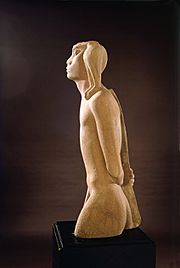
In the early 1900s, Jews were very important in the Montparnasse art movement in Paris. This included artists like Chaïm Soutine and Marc Chagall. After World War II, many Jews became important abstract expressionists, such as Mark Rothko. Many Russian Jews were also famous for scenic design (designing sets for plays). While many Jewish artists participated in the cultures around them, their work often blended Jewish and other cultural elements.
Jews have also played a very important role in other art forms. Their involvement in sculpture came later, perhaps due to the old rule against "graven images." But many notable Jewish sculptors emerged in the late 1800s and 1900s, including Sir Jacob Epstein and Louise Nevelson. In photography, important figures include Robert Frank and Helmut Newton.
| Camille Pissarro (1830–1903) |
Amedeo Modigliani (1884–1920) |
Diego Rivera (1886–1957) |
Alexander Bogen (1916–2010) |
Marc Chagall (1887–1985) |
|---|---|---|---|---|
Comics, Cartoons, and Animation
Comics have been a key area for Jewish artists. In the early days of American comic books, many of the most important creators were Jewish.
Max Gaines was a pioneer in creating the modern comic book in 1935. He later co-founded All-American Publications, known for creating superheroes like Wonder Woman. Harry Donenfeld and Jack Liebowitz also owned the company that became DC Comics.
In 1939, Martin Goodman started Timely Comics, which later became Marvel Comics. At Marvel, artists like Stan Lee, Jack Kirby, and Joe Simon created many famous characters. These include Spider-Man, Hulk, Captain America, and teams like Fantastic Four and Avengers. Stan Lee said that Jewish culture influenced the role of Jews in comics.
At DC Comics, the Jewish role was also important. The character of Superman, created by Jewish artists Joe Shuster and Jerry Siegel, was partly inspired by the biblical figure of Samson and other Jewish ideas. Other Jewish creators at DC Comics include Bob Kane and Bill Finger, who created Batman. Many Jewish characters also appear in comics, often influenced by Jewish history.
Will Eisner was an American cartoonist known for his early work in comic books. He created Spirit and the graphic novel A Contract with God. The Eisner Award for comics is named after him.
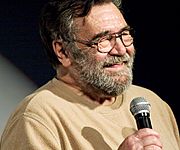
In 1952, William Gaines and Harvey Kurtzman founded Mad magazine, a very influential humor magazine. Other famous cartoonists include Lee Falk (creator of The Phantom) and Art Spiegelman (creator of the graphic novel Maus).
In animation, many Jewish animators have made their mark. Genndy Tartakovsky created TV series like Dexter's Laboratory and Samurai Jack. Matt Stone co-created South Park. Friz Freleng worked on Looney Tunes. Ralph Bakshi directed animated films like Fritz the Cat. Several animation companies were founded by Jews, including DreamWorks (known for Shrek) and Warner Bros. (known for Looney Tunes).
Cuisine and Food
Jewish cooking combines foods from many cultures where Jews have lived. These include Middle Eastern, Mediterranean, Spanish, German, and Eastern European styles. All of these are influenced by the need for food to be kosher (following Jewish dietary laws). So, "Jewish" foods like bagels, hummus, and blintzes come from various other cultures. The mix of these foods, plus unique Jewish dishes like cholent and matzah balls, makes up Jewish cuisine.
Philo-Semitism (Appreciation of Jewish Culture)
Philo-Semitism means having an interest in, respect for, and appreciation of Jewish people, their history, and their culture. This is especially true when it comes from non-Jewish people. Within the Jewish community, it means having an interest in Jewish culture and loving things considered Jewish.
Very few Jews live in East Asian countries. But Jews are often seen in a very positive light there, partly because of shared experiences during World War II. For example, in South Korea, students are required to read the Talmud. Generally, Jews are positively seen as intelligent, good at business, and committed to family.
See also
 In Spanish: Cultura judía para niños
In Spanish: Cultura judía para niños
- Culture of Israel
- Humanistic Judaism
- Jewish folklore
- Jewish studies
- Jews and Christmas
- Secular Culture & Ideas
- Traditional Jewish chronology
- Yiddishkeit
Images for kids


